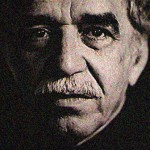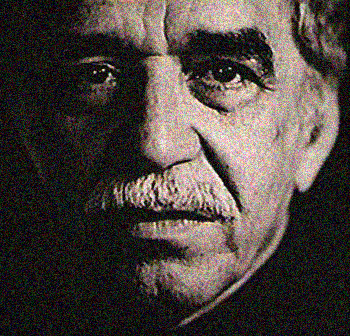Re-reading Márquez

Gabriel García Márquez, Love in the Time of Cholera
Penguin New Edition, as part of a reissue of the complete set of his novels.
No novelist since Proust has had a more acute sense of smell than Márquez . Penguin should have reissued these books with sprayed strips of paper interspersed between the leaves, like a perfumerie. The hot still air of his un-named Caribbean port , the ‘city of the Viceroys’, is enveloped by the ‘the tender breath of human shit, warm and sad,’ against which his protagonists wear imported Cologne from Farina Gegenuber and the houses are filled with pots of heliotrope to perfume the dusk.
For fifty odd years the melancholy Florentino Ariza pursues the gardenia scent of Fermina Diaz, the married woman he loves so hopelessly, roaming the city to revisit places where he thinks he will smell her presence. And Fermina herself discovers that her husband is cheating on her, the most traumatic moment of the marriage, when she detects the odour of a black woman on his laundry when she sniffs it, as is her custom. The very first opening lines of the book are about the scent of bitter almonds that remind Dr Urbino of the fate of unrequited love.
Yet it would be a mistake to take the common view of Márquez as primarily a glorious sensualist, ‘the most evocative of writers’ lauded by Penguin in their marketing, however sparkling the prose in one of Edith Grossman’s best translations. For along with the heady floral notes, there is a base layer of mordant regret underpinning both this and his other novels. The smell of bitter almonds is that of cyanide, the recourse for frustrated lovers; the perfume of Fermina Diaz fades for Florentino even when he drinks a litre bottle of cologne in an attempt never to lose it. The infusions of linden blossoms that a doctor then prescribes for him are because the symptoms of extreme love, far from being romantic, are the same as those for cholera. And the cholera of the title is no evocation of a romantic Edwardian age: in Márquez, characters live for love but also die out of neglect, loveless, and with all the symptoms of the virulent disease that has killed Dr Urbino’s father and can rise up again from the pestilent city , however closely the aristocrats in their decaying palaces hold up perfumed handkerchiefs against it.
The presiding impulse in Márquez is that of loss, loss both of love but also time, which is why his greatest novels, like this and One Hundred Years of Solitude, give themselves such long and winding timescales to unfold over: ‘The very life of the colonial city, which the young Juvenal Urbino tended to idealise in his Parisian melancholy, was an illusion of memory.’ Márquez moves so restlessly backwards and forwards across the years during the telling of his story and his building up of the ‘illusion of memory’ that I defy any reader to collate a chronological ordering of events, let alone of Florentino’s many loves and conquests as he tries to forget the smell of Fermina. No other novelist can make the reader feel that they are themselves continually forgetting what he has just told them.
And along with loss comes anger – anger at what time does to the body, at what Colombia’s perpetual civil war has done to the poor and the plantation workers, killed with a coup-de-grace to the head. His romance is one of defiance, of love as something that stands against the tide of decay and death in a city rotting from the inside. The steam-boat journey that the finally reunited lovers make – when they can now smell the sour breath of old age on one another – is down a river denuded of trees, of people, of hope; they raise the yellow flag as if there were cholera on board, to isolate themselves from such a world.
Of course we are now re-reading Márquez in the light of his last novella, Memories of my Melancholy Whores, which disconcerted many critics with its asperity and controversial theme – the prurient love of an old man for a very young girl. Those expecting ‘Gabo’, the old master in his eighties, to produce a mellow, sensual classic did not quite know what to make of a book that was more Lolita than Old Man and the Sea. But then perhaps they had not been reading the earlier novels carefully enough.
—————-
You can listen to Hugh discuss Márquez in the BBC’s A Good Read


Hola Hugh,
I’ve travelled through the Cordillera Vilcabamba backpacking several times.
I’ve also travelled there through The White Rock.
I’m very interested in travel literature, focused specifically in Peru.
Your article on García Márquez shows you’re deeply involved with literature as well.
I guess you have read famous José María Argueda´s Deep Rivers (Los ríos profundos), it is a novel many travelers enjoy before or after Cusco.
Less popular is another indigenista; Ciro Alegría.
Alegrian literature is also deeply rooted in the Andean geography; the Marañón Canyon is omnipresent in The Golden Serpent and in Broad and Alien is the World.
Alegría’s short stories have remained hidden behind his acclaimed novels and there is a short story I would like to recommend you read; La ofrenda de piedra, The Stone Offering. It is a tale that discusses religious confrontation between indian and white while on a day’s journey to the puna and ends up metaphorically proclaiming a mestizo cult.
You have probably passed by several “apachetas” on your Andean Wanderings, I’ve made a few myself. This short tale is the story of the deep feelings, the devotion and fear of nature behind an apacheta or stone offering.
Check out an extract of La ofrenda de Piedra here:
http://travelyoung.wordpress.com/?s=alegria
Hope you enjoy it.
Un abrazo!
H